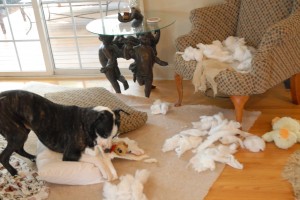
I’ve been so busy!
Puppy proofing your home: Congratulations on your newest family member! Your puppy does not yet know right from wrong or how to live in your household. What he does know is that anything within his reach is a potential chew toy. He can’t help chewing, HE HAS TO DO IT.
Puppies learn about their world and the objects in it by using their mouths. Help your puppy to do the right thing by carefully puppy proofing the rooms he will be in. Virtually all dog owners have chewing and destruction tales to share. Know that being a puppy owner means you will likely lose something to puppy chewing. How many objects you lose however is really up to you.
Puppies do not know the difference between what is acceptable to chew and what is not. It is the owner’s responsibility to remove chewing temptations and to proactively guard against losing treasured possessions.
Step One: Select the primary room that puppy is allowed in when he’s out of his crate.
Step Two: Walk through the room and ask yourself, “What is in this room that is not replaceable? What objects are sentimental?” Remove all objects that make it to your list. Do you have cherished oriental rugs? Collector edition books? Irreplaceable figurines? Ornate couch or chair pillows? Books on bookshelves or racks holding CD’s or magazines? Potted plants? Pack these objects up and put them away until puppy is much older.
Step Three: Now that you have removed your valuables, it is time to see the room from puppy’s perspective and there is only way to do this…on hands and knees. Start in one corner of the room and work your way all the way around the room. What’s dangling to entice puppy? Perhaps there is extra fabric or tags stapled under a chair, phone cords or lighting cords dangling from tables or decorator cords or fringe on furniture or drapes. If an object is dangling, it’s a beacon to puppy and most certainly will be chewed. If your drapes or blinds hang within puppy’s reach, pin or roll them up so that puppy cannot get to them. Magazine racks, books, CD’s and DVD’s, if stored within puppy’s reach, should be removed. Wires, particularly in groups such as for your stereo or TV system, can be placed in plastic tubing made specifically for this purpose. Tubing is inexpensive, easy to use and can be found at most home centers. If you cannot protect the wires with tubing, consider elevating them to a place that puppy cannot reach or blocking puppy’s access to them.
Step Four: When you have finished investigating from the ground, return to your original starting point in the room. One by one, working your way around the room, sit on every piece of furniture you come to. What’s in your line of sight from this position? What objects are within grabbing or chewing reach? Perhaps a cordless phone, the remote control? Candles, candy dish or drink coasters? A blanket draped over the back of the couch with wonderfully tempting fringe? Yes, you guessed it, move all of those objects to higher ground if you cannot remove them from the room. Please don’t second-guess which objects your puppy will chew. He will chew anything he can reach including glass, metal and other objects that you would never imagine until you see it for yourself. Don’t take chances! If “it” is within reach, move “it” out of range. If the thought of a nearly empty room depresses you, remember that puppyhood is very short. As your puppy grows, learns and becomes trustworthy, you can decorate again.
Step Five: Close doors to other rooms in the house and/or block them off with baby gates. Puppies should never have free run of your home; that’s like giving your car keys to your 6 year old! He simply is not ready for this responsibility and will not make good decisions.
Tip: To prevent puppy from hiding, denning, or getting stuck under your couch, push empty boxes or under-bed plastic containers under the couch to prevent puppy and his toys from getting in.

